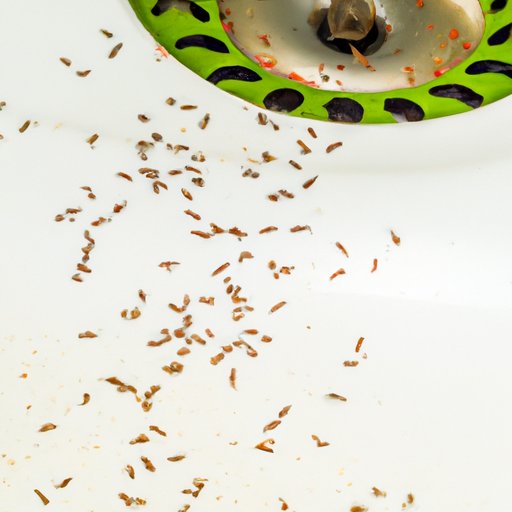Introduction
Gnats are small flying insects that are common household pests. These tiny creatures can be found swarming around windowsills, hovering over countertops, and generally buzzing around any damp, dark areas of the home. In particular, they often appear in kitchens, where they can be especially annoying and even hazardous to health. But where do these pesky gnats come from in the first place? In this article, we’ll explore the origins of gnats in the kitchen and discuss how you can prevent and treat gnat infestations.
Exploring the Origins of Gnats in the Kitchen
Gnats thrive in moist, dark environments, so it’s no surprise that they’re often found in kitchens. There are several potential sources for gnat infestations in kitchen spaces, including food and drinks, drains and sinkholes, trash cans and compost piles, and moisture sources.
Food and Drinks
One of the most common sources of gnats in the kitchen is food and drink spills. Gnats are attracted to sweet substances like juices and syrups, as well as sticky foods like honey or jam. If these items are spilled on the floor or countertop, they can attract gnats and other pests. It’s important to clean up any food or drink spills promptly to avoid an infestation.
Drains and Sinkholes
Gnats can also breed in drains and sinkholes. These areas are often moist and dark, making them ideal breeding grounds for gnats and other pests. To prevent an infestation, it’s important to keep drains and sinkholes clean and free of debris.
Trash Cans and Compost Piles
Another source of gnats in the kitchen is trash cans and compost piles. These areas are often moist and provide a perfect environment for gnats to lay their eggs. To prevent an infestation, it’s important to empty and clean trash cans regularly and keep compost piles away from the kitchen.
Moisture Sources
Finally, gnats can also breed in areas with high levels of moisture. This includes damp towels, wet sponges, and other wet surfaces. To prevent an infestation, it’s important to keep kitchen surfaces dry and avoid leaving wet towels lying around.

Understanding the Lifecycle of Gnats to Combat Kitchen Infestations
Gnats have four stages in their lifecycle: egg, larva, pupa, and adult. The female gnat lays her eggs in moist areas such as soil, compost, or drains. After several days, the eggs hatch into larvae, which feed on organic matter. The larvae then enter the pupal stage and eventually emerge as adults. Adult gnats are typically active during the day and feed on sugary substances. Understanding the lifecycle of gnats can help you identify potential breeding sites and take steps to prevent and control an infestation.

Preventing and Treating Gnat Invasions in Kitchens
The best way to deal with gnats in the kitchen is to take preventive measures. Here are some tips for keeping gnats away from your kitchen:
Cleaning Up Food and Drink Spills
As mentioned earlier, food and drink spills can attract gnats. To prevent an infestation, it’s important to clean up any spills promptly. Wipe down counters and floors regularly to remove any spilled substances that might attract gnats.
Proper Disposal of Organic Waste
Organic waste is another source of gnat infestations. To avoid attracting gnats, it’s important to dispose of organic waste properly. Empty and clean trash cans and compost piles regularly to prevent an infestation.
Keeping Kitchen Areas Dry
Moisture is another factor that can attract gnats. To prevent an infestation, it’s important to keep kitchen areas dry. Wipe down counters and other surfaces after cooking or cleaning to remove any moisture that might attract gnats.
Using Natural Repellents to Keep Gnats Away
There are a number of natural repellents that can be used to keep gnats away from the kitchen. Citrus oils, cinnamon, and garlic are all effective at repelling gnats. You can also use vinegar or peppermint oil to create a DIY gnat repellent.
Using Chemical Insecticides Judiciously
In extreme cases, chemical insecticides may be necessary to get rid of gnats. However, it’s important to use these products judiciously. Follow the instructions carefully and wear protective clothing when applying the insecticide.

What You Need to Know About Gnats in Your Kitchen
Gnats can be a nuisance in the kitchen, but there are ways to prevent and treat infestations. Here are some key things to remember about gnats in the kitchen:
Recognizing Signs of an Infestation
If you suspect that you have a gnat infestation, look for signs such as swarms of flies, sticky surfaces, or evidence of eggs or larvae. If you notice any of these signs, take action immediately to prevent the infestation from spreading.
Avoiding Contact with Gnats
It’s important to avoid contact with gnats whenever possible. Wear protective clothing when dealing with an infestation and wash your hands thoroughly after handling any materials that may have been exposed to gnats.
Conclusion
Gnats can be a nuisance in the kitchen, but with proper prevention and treatment, you can keep them under control. To prevent an infestation, it’s important to clean up food and drink spills promptly, dispose of organic waste properly, keep kitchen areas dry, and use natural repellents to keep gnats away. If necessary, judicious use of chemical insecticides may be necessary. By following these best practices, you can keep gnats out of your kitchen and enjoy a pest-free space.


